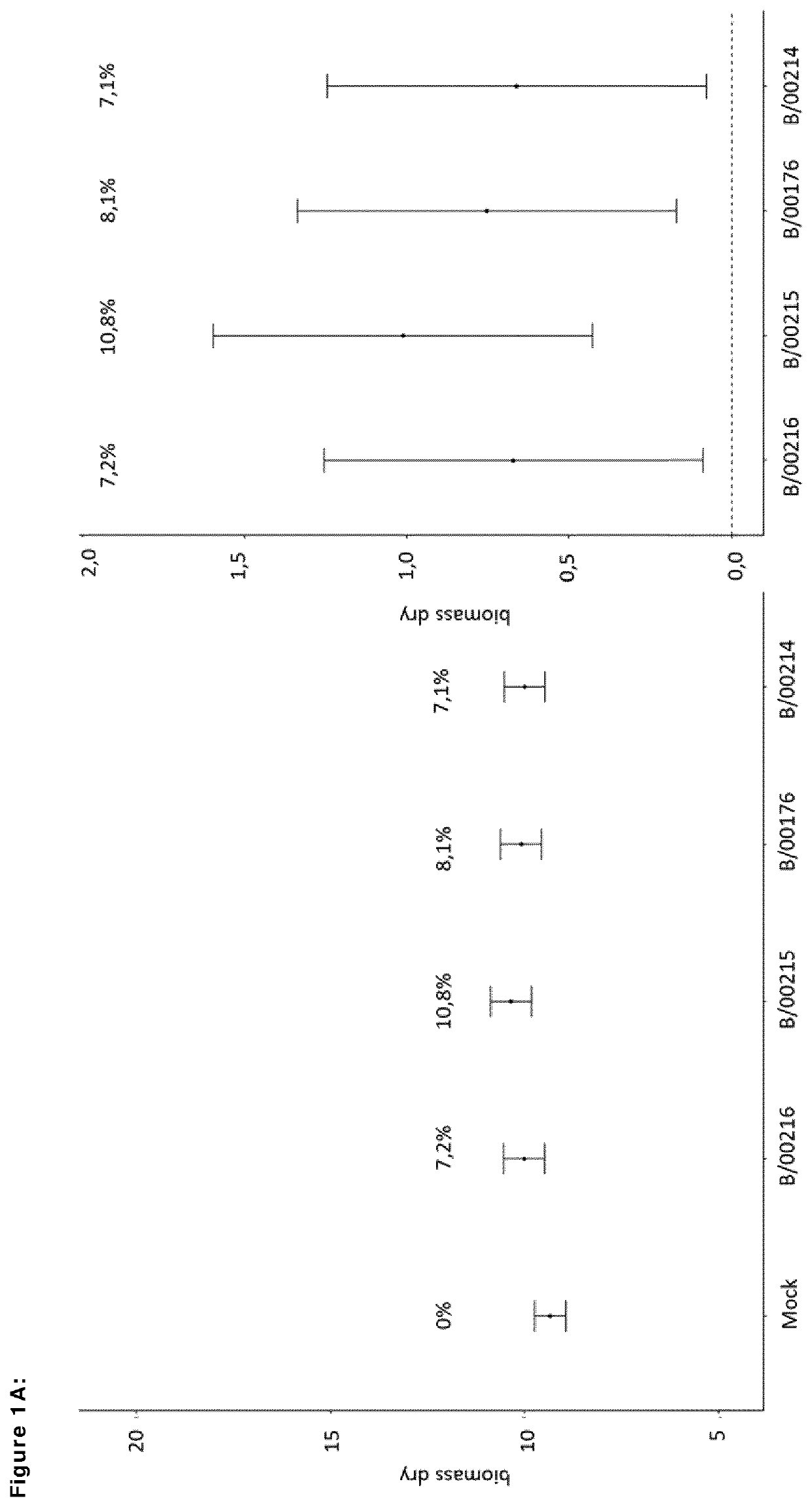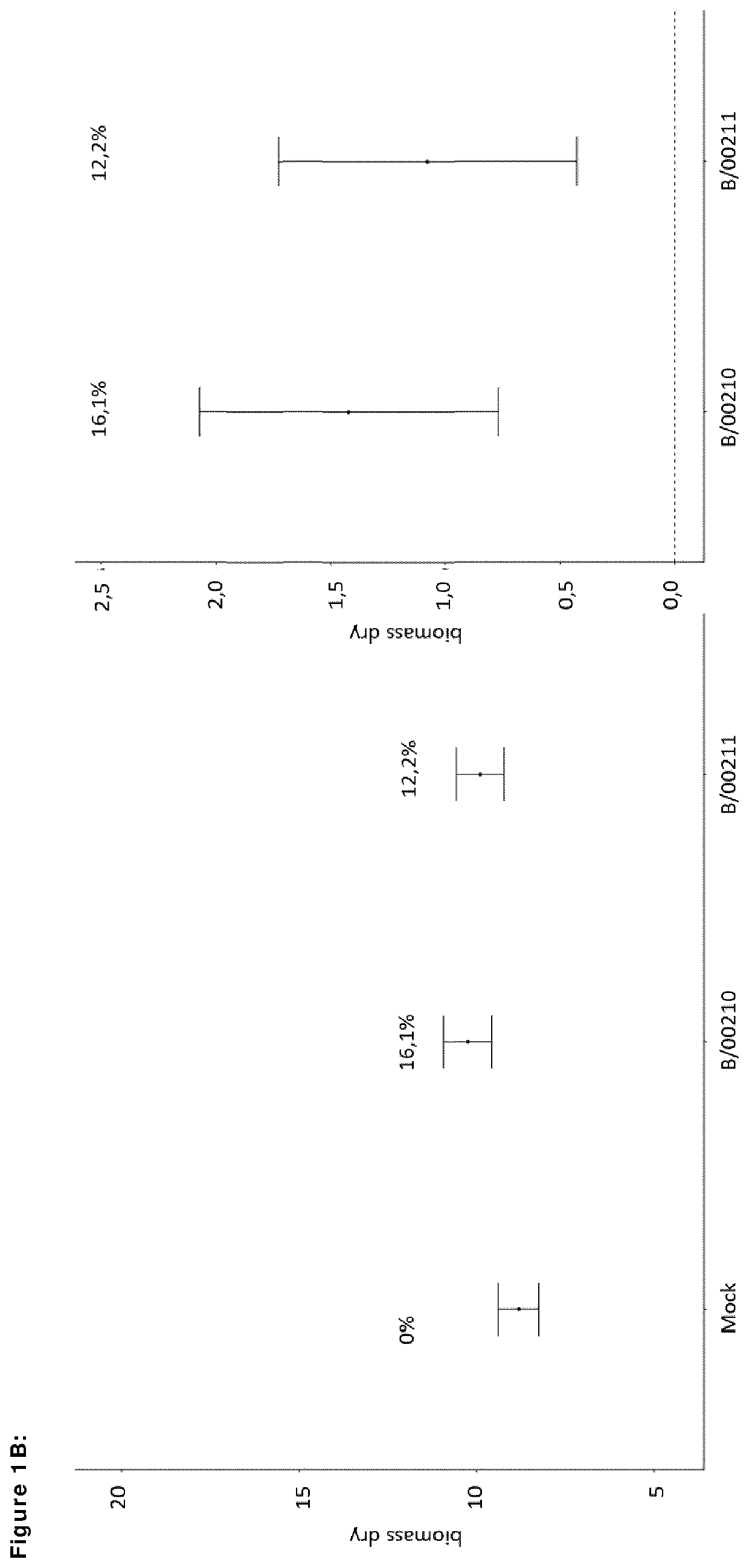Means and Methods for Improving Plant Growth and Yield
- Summary
- Abstract
- Description
- Claims
- Application Information
AI Technical Summary
Benefits of technology
Problems solved by technology
Method used
Image
Examples
example 1
Dry Biomass and Increased Number of Tillers Per Plant in Wheat
[0155]Per treatment, 5×24 wheat seeds are treated with a formulation containing a bacterial strain. Five planter boxes are filled with potting soil mix and saturated with water. As a control, 10×24 wheat seeds are treated with a formulation without bacterial strain to compare (mock treatment). Seeds are sown in three rows of 8 seeds per planter box. Nutrients are being added to the planter boxes at two and three weeks after sowing. The number of tillers per plant are counted at 6 weeks after sowing the wheat plants obtained from seeds treated with said the bacterial strain. After counting the number of tiller per plant, all shoots are cut off and fresh biomass is weighed per planter box (i.e. all 24 shoots together). Plant shoots are then dried at 60° C. for 1 week and dry biomass (in mg) is determined per planter box.
[0156]For all evaluated formulations, each containing a bacterial strain of current invention, an increas...
example 2
Dry Biomass Per Plant in Wheat
[0157]Per treatment, 5×24 wheat seeds are treated with a formulation comprising two or six bacterial strains of current invention. Five planter boxes are filled with potting soil mix and saturated with water. As a control, 10×24 wheat seeds are treated with a formulation without bacterial strain to compare (mock treatment). Seeds are sown in three rows of 8 seeds per planter box. Nutrients are being added to the planter boxes at two and three weeks after sowing. Plant height of the middle row is measured 5 weeks after sowing. Six weeks after sowing, all shoots are cut off and fresh biomass is weighed per planter box (i.e. all 24 shoots together). Plant shoots are then dried at 60° C. for 1 week and dry biomass (in mg) is determined per planter box. A combination of two bacterial strains of current invention demonstrate an increase of 12.7% dry biomass (in mg) in reference to the mock (FIG. 3). A combination of six bacterial strains of current invention ...
example 3
Dry Biomass Per Plant in Maize
[0158]Per treatment, 5×24 maize seeds are treated with a whole cell broth wherein a purified bacterial strain a member of genus Modestobacter with Deposit ID B / 00212 was incubated. Five planter boxes are filled with potting soil mix and saturated with water. As a control, 10×24 maize seeds are treated with a formulation without bacterial strain to compare (mock treatment). Seeds are sown in three rows of 8 seeds per planter box. Nutrients are being added to the planter boxes at two and three weeks after sowing. Plant height of the middle row is measured 5 weeks after sowing. Six weeks after sowing, all shoots are cut off and fresh biomass is weighed per planter box (i.e. all 24 shoots together). Plant shoots are then dried at 60° C. for 1 week and dry biomass (in mg) is determined per planter box. Maize plants treated with a whole cell broth wherein B / 00212 was incubated show a 15.5% increase of dry biomass in reference to maize plants treated with a mo...
PUM
 Login to View More
Login to View More Abstract
Description
Claims
Application Information
 Login to View More
Login to View More - R&D
- Intellectual Property
- Life Sciences
- Materials
- Tech Scout
- Unparalleled Data Quality
- Higher Quality Content
- 60% Fewer Hallucinations
Browse by: Latest US Patents, China's latest patents, Technical Efficacy Thesaurus, Application Domain, Technology Topic, Popular Technical Reports.
© 2025 PatSnap. All rights reserved.Legal|Privacy policy|Modern Slavery Act Transparency Statement|Sitemap|About US| Contact US: help@patsnap.com



